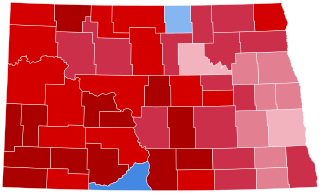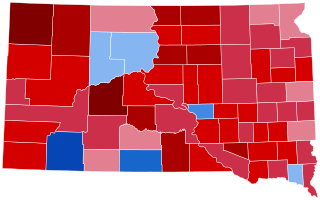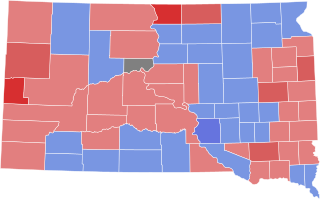
John N. Hagan was a North Dakota Republican/NPL politician who served as the North Dakota Commissioner of Agriculture and Labor from 1917 to 1921 and from 1937 to 1938. He is one of three politicians in the state ever to be recalled; he was recalled during his first time in the office along with fellow NPL politicians Governor of North Dakota Lynn J. Frazier and North Dakota Attorney General William Lemke in 1921.

A general election was held in the U.S. state of North Dakota on Tuesday, November 2, 2010, with primary elections being held on June 8, 2010.

The 1944 United States Senate election in North Dakota took place on November 7, 1944. Incumbent Republican Senator Gerald Nye ran for re-election to his fourth term. He faced a serious challenge to his renomination in the Republican primary, with prominent Fargo attorney Lynn Stambaugh and Congressman Usher L. Burdick running against him. He won with one-third of the vote, defeating Shambaugh, his closest opponent, by fewer than 1,000 votes. In the general election, Stambaugh continued his campaign against Nye as an independent, splitting the Republican vote as Governor John Moses, the Democratic nominee, ran a strong campaign. Though Nye had benefited from crowded general elections before, he bled Republican support to Stambaugh and Moses unseated him with just 45% of the vote. However, just a few months into Moses's term, he died in office, flipping the seat back to Republican control and triggering a June 1946 special election.

The 2016 United States presidential election in North Dakota was held on Tuesday, November 8, 2016, as part of the 2016 United States presidential election in which all 50 states plus the District of Columbia participated. North Dakota voters chose electors to represent them in the Electoral College via a popular vote, pitting the Republican nominee, businessman Donald Trump, and running mate Indiana Governor Mike Pence against Democratic nominee, former Secretary of State Hillary Clinton, and her running mate Virginia Senator Tim Kaine. North Dakota has three electoral votes in the Electoral College.

The 2020 United States presidential election in North Dakota was held on Tuesday, November 3, 2020, as part of the 2020 United States presidential election in which all 50 states plus the District of Columbia participated. North Dakota voters chose electors to represent them in the Electoral College via a popular vote, pitting the Republican nominee, incumbent President Donald J. Trump from Florida, and running mate Vice President Michael R. Pence from Indiana against Democratic nominee, former Vice President Joe Biden from Delaware, and his running mate Senator Kamala Harris of California. North Dakota has three electoral votes in the Electoral College.

The 2020 United States presidential election in South Dakota was held on Tuesday, November 3, 2020, as part of the 2020 United States presidential election in which all 50 states plus the District of Columbia participated. South Dakota voters chose electors to represent them in the Electoral College via a popular vote, pitting the Republican Party's nominee, incumbent President Donald Trump, and running mate Vice President Mike Pence against Democratic Party nominee, former Vice President Joe Biden, and his running mate California Senator Kamala Harris. South Dakota has three electoral votes in the Electoral College.

The 1948 North Dakota gubernatorial election was held on November 2, 1948. Incumbent Republican Fred G. Aandahl defeated Democratic nominee Howard I. Henry with 61.33% of the vote.

The 1942 North Dakota gubernatorial election was held on November 3, 1942. Incumbent Democrat John Moses defeated Republican nominee Oscar W. Hagen with 57.62% of the vote.

The 1940 North Dakota gubernatorial election was held on November 5, 1940. Incumbent Democrat John Moses defeated Republican nominee Jack A. Patterson with 63.11% of the vote. This election marked the first time since 1910 that an incumbent Democratic Governor was re-elected or won re-election.

The 1936 North Dakota gubernatorial election was held on November 3, 1936. Nonpartisan League nominee William Langer defeated incumbent Republican Walter Welford with 35.80% of the vote.

The 1934 North Dakota gubernatorial election was held on November 6, 1934. Democratic nominee Thomas H. Moodie defeated Republican nominee Lydia Cady Langer with 52.98% of the vote.

The 1932 North Dakota gubernatorial election was held on November 8, 1932. Republican nominee William Langer defeated Democratic nominee Herbert C. DePuy with 54.75% of the vote.

The 1930 North Dakota gubernatorial election was held on November 4, 1930. Incumbent Republican George F. Shafer defeated Democratic nominee Pierce Blewett with 73.62% of the vote.

The 1928 North Dakota gubernatorial election was held on November 6, 1928. Republican nominee George F. Shafer defeated Democratic incumbent Walter Maddock with 56.50% of the vote.

The 1918 North Dakota gubernatorial election was held on November 5, 1918. Incumbent Republican Lynn Frazier defeated Democratic nominee S. J. Doyle with 59.75% of the vote.

The 1916 North Dakota gubernatorial election was held on November 7, 1916. Republican nominee Lynn Frazier defeated Democratic nominee D. H. McArthur with 79.24% of the vote.

The 1914 North Dakota gubernatorial election was held on November 3, 1914. Incumbent Republican L. B. Hanna defeated Democratic nominee Frank O. Hellstrom with 49.58% of the vote.

The 1912 North Dakota gubernatorial election was held on November 5, 1912. Republican nominee L. B. Hanna defeated Democratic nominee Frank O. Hellstrom with 45.45% of the vote.

The 1910 North Dakota gubernatorial election was held on November 8, 1910. Incumbent Democrat John Burke defeated Republican nominee C. A. Johnson with 49.96% of the vote.

The 1938 United States Senate elections in South Dakota took place on November 8, 1938. Incumbent Republican Senator Peter Norbeck died in office on December 20, 1936. Herbert E. Hitchcock was appointed by Governor Tom Berry as Norbeck's replacement. Two elections for the same Senate seat were held on the same day; one as a special election to fill the remainder of Norbeck's six-year term, and another to select a Senator to serve the next six-year term.























